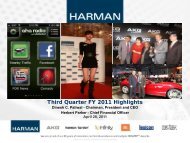You also want an ePaper? Increase the reach of your titles
YUMPU automatically turns print PDFs into web optimized ePapers that Google loves.
<strong>Harman</strong> International Industries, Incorporated and Subsidiaries<br />
(Dollars in thousands, except per-share data and unless otherwise indicated)<br />
The following table provides the fair value hierarchy for financial assets and liabilities measured on a<br />
recurring basis:<br />
Assets/(Liabilities)<br />
Level 1<br />
June 30, 2009<br />
Level 2 Level 3<br />
Money market funds ................................................. $17,937 $ — $—<br />
Available-for-sale securities ........................................... 1,358 — —<br />
Foreign currency forward contracts ...................................... — (12,871) —<br />
Interest rate swap contract ............................................. — (1,767) —<br />
Total .............................................................. $19,295 $(14,638) $—<br />
Money market funds and available-for-sale-securities are classified as Level 1 as the fair value was<br />
determined from market quotes obtained from financial institutions in active markets.<br />
We use foreign currency forward contracts and an interest rate swap contract to hedge market risks relating<br />
to possible adverse changes in foreign currency exchange rates and interest rates. Our foreign currency forward<br />
contracts were measured at fair value using Level 2 inputs. Such inputs include foreign currency spot and<br />
forward rates for similar transactions in actively quoted markets.<br />
We have elected to use the income approach to value our interest rate swap contract, which uses observable<br />
Level 2 inputs at the measurement date and standard valuation techniques to convert future amounts to a single<br />
present amount (discounted). Level 2 inputs for the swap contract valuation are limited to quoted prices for<br />
similar assets or liabilities in active markets (specifically futures contracts on) and inputs other than quoted prices<br />
that are observable for the asset or liability (specifically Euro Interbank Offered Rate (“EURIBOR”) cash and<br />
swap rates EURIBOR and six by three month basis swap rates) at commonly quoted intervals, and credit<br />
risk. These key inputs, including the EURIBOR cash rates for very short-term, futures rates for up to two years,<br />
and EURIBOR swap rates beyond the derivative maturity are used to construct the swap yield curve and discount<br />
the future cash flows to present value at the measurement date. As the interest rate swap contract is a derivative<br />
liability, we have used our spread over LIBOR of five percent, applied to all cash flows to calculate the credit<br />
adjusted fair market value. If the interest rate swap contract was determined to be a derivative asset, we would<br />
use the credit default swap basis for our counterparty collected from Bloomberg to further discount the asset. See<br />
Note 8 – Derivatives, for further discussion regarding our derivative financial instruments.<br />
In accordance with the requirements of SFAS No. <strong>10</strong>7, “Disclosures about Fair Value of Financial<br />
Instruments”, we annually disclose the fair value of our debt, which is recorded in the Consolidated Balance<br />
Sheets at adjusted cost. The carrying value and fair value of long-term debt was $629.5 million and $548.5<br />
million, respectively, at June 30, 2009. Refer to Note 6 – Debt for further information.<br />
In February 2007, the FASB issued SFAS 159, which allows an entity the irrevocable option to elect fair<br />
value for the initial and subsequent measurement of certain financial assets and liabilities on an<br />
instrument-by-instrument basis. Unrealized gains and losses on items for which the fair value option has been<br />
elected are reported in earnings. We did not elect fair value measurement for financial assets and<br />
liabilities. Therefore, SFAS 159 did not impact our results of operations.<br />
In February 2008, the FASB issued FSP 157-2 which delays the effective date of SFAS 157 by one year for<br />
nonfinancial assets and liabilities that are recognized or disclosed at fair value in the financial statements on a<br />
nonrecurring basis. The provisions of SFAS 157 for nonfinancial assets and liabilities will be adopted by us in<br />
the first quarter of fiscal year 20<strong>10</strong>.<br />
72





